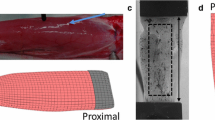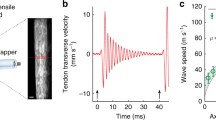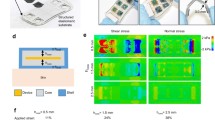Abstract
Intramuscular pressure (IMP) shows promise for estimating individual muscle tension in vivo. However, previous pressure measurements show high variability during isometric contraction and poor correlation with tension during dynamic contraction. We hypothesized that enhanced sensor anchoring/orientation would improve tension estimation and thus developed a novel pressure sensor with a barbed housing. Sensors were inserted into the tibialis anterior (TA) of New Zealand White rabbits (N = 8) both parallel and perpendicular to the fiber orientation. We measured muscle stress and IMP during both isometric and dynamic contractions. Passive stress showed good agreement for both insertion directions across muscle lengths (ICC > 0.8). Active stress and IMP agreement were good (ICC = 0.87 ± 0.04) for perpendicular insertions but poor (ICC = 0.21 ± 0.22) for parallel insertions across both dynamic contractions and isometric contractions within the muscle’s range of motion. These findings support use of IMP measurements to estimate muscle tension across a range of contraction conditions.




Similar content being viewed by others
Abbreviations
- IMP:
-
Intramuscular pressure
- COV:
-
Coefficient of variation
- TA:
-
Tibialis anterior
- ROM:
-
Range of motion
- HA:
-
Hyaluronic acid
- PCSA:
-
Physiological cross-sectional area
- COD:
-
Coefficient of determination
- ICC:
-
Intraclass correlation coefficient
References
Aratow, M., R. E. Ballard, A. G. Crenshaw, J. Styf, D. E. Watenpaugh, N. J. Kahan, and A. R. Hargens. Intramuscular pressure and electromyography as indexes of force during isokinetic exercise. J. Appl. Physiol. 74(2634–2640):1993, 1985.
Ballard, R. E., D. E. Watenpaugh, G. A. Breit, G. Murthy, D. C. Holley, and A. R. Hargens. Leg intramuscular pressures during locomotion in humans. J. Appl. Physiol. 84(1976–1981):1998, 1985.
Close, R. I. Dynamic properties of mammalian skeletal muscles. Physiol. Rev. 52:129–197, 1972.
Cottler, P. S., W. R. Karpen, D. A. Morrow, and K. R. Kaufman. Performance characteristics of a new generation pressure microsensor for physiologic applications. Ann. Biomed. Eng. 37:1638–1645, 2009.
Crenshaw, A. G., J. R. Styf, and A. R. Hargens. Intramuscular pressures during exercise: an evaluation of a fiber optic transducer-tipped catheter system. Eur. J. Appl. Physiol. Occup. Physiol. 65:178–182, 1992.
Crenshaw, A. G., J. R. Styf, S. J. Mubarak, and A. R. Hargens. A new “transducer-tipped” fiber optic catheter for measuring intramuscular pressures. J. Orthop. Res. 8:464–468, 1990.
Davis, J., K. R. Kaufman, and R. L. Lieber. Correlation between active and passive isometric force and intramuscular pressure in the isolated rabbit tibialis anterior muscle. J. Biomech. 36:505–512, 2003.
Davis, J., K. R. Kaufman, and R. L. Lieber. Correlation between active and passive isometric force and intramuscular pressure in the isolated rabbit tibialis anterior muscle. J. Biomech. 36:505–512, 2003.
Degens, H., S. Salmons, and J. C. Jarvis. Intramuscular pressure, force and blood flow in rabbit tibialis anterior muscles during single and repetitive contractions. Eur. J. Appl. Physiol. Occup. Physiol. 78:13–19, 1998.
Go S. A., E. R. Jensen, S. M. O’Connor, L. Q. Evertz, D. A. Morrow, S. R. Ward, R. L. Lieber, and K. R. Kaufman. Design considerations of a fiber optic pressure sensor protective housing for intramuscular pressure measurements. Ann. Biomed. Eng. 1–8, 2016.
Harry, J. D., A. W. Ward, N. C. Heglund, D. L. Morgan, and T. A. McMahon. Cross-bridge cycling theories cannot explain high-speed lengthening behavior in frog muscle. Biophys. J. 57:201–208, 1990.
Hill, A. V. The heat of shortening and the dynamic constants of muscle. Proc. R. Soc. Lond. B 126:136–195, 1938.
Hug, F., K. Tucker, J. L. Gennisson, M. Tanter, and A. Nordez. Elastography for muscle biomechanics: toward the estimation of individual muscle force. Exerc. Sport Sci. Rev. 43:125–133, 2015.
Jenkyn, T. R., B. Koopman, P. Huijing, R. L. Lieber, and K. R. Kaufman. Finite element model of intramuscular pressure during isometric contraction of skeletal muscle. Phys. Med. Biol. 47:4043–4061, 2002.
Katz, B. The relation between force and speed in muscular contraction. J. Physiol. 96:45–64, 1939.
Kaufman, K. R., T. Wavering, D. Morrow, J. Davis, and R. L. Lieber. Performance characteristics of a pressure microsensor. J. Biomech. 36:283–287, 2003.
Kirkebo, A., and A. Wisnes. Regional tissue fluid pressure in rat calf muscle during sustained contraction or stretch. Acta Physiol. Scand. 114:551–556, 1982.
Koo, T. K., and M. Y. Li. A guideline of selecting and reporting intraclass correlation coefficients for reliability research. J. Chiropr. Med. 15:155–163, 2016.
Lieber, R. L., and F. T. Blevins. Skeletal muscle architecture of the rabbit hindlimb: functional implications of muscle design. J. Morphol. 199:93–101, 1989.
Nakhostine, M., J. R. Styf, S. van Leuven, A. R. Hargens, and D. H. Gershuni. Intramuscular pressure varies with depth. The tibialis anterior muscle studied in 12 volunteers. Acta Orthop. Scand. 64:377–381, 1993.
Ozerdem, U. Measuring interstitial fluid pressure with fiberoptic pressure transducers. Microvasc. Res. 77:226–229, 2009.
Rassier, D. E., and B. R. MacIntosh. Length-dependent twitch contractile characteristics of skeletal muscle. Can. J. Physiol. Pharmacol. 80:993–1000, 2002.
Sacks, R. D., and R. R. Roy. Architecture of the hind limb muscles of cats: functional significance. J. Morphol. 173:185–195, 1982.
Sejersted, O. M., and A. R. Hargens. Intramuscular pressures for monitoring different tasks and muscle conditions. Adv. Exp. Med. Biol. 384:339–350, 1995.
Styf, J. Compartment Syndromes : Diagnosis, Treatment, and Complications. Boca Raton: CRC Press, p. 301, 2004.
Styf, J., R. Ballard, M. Aratow, A. Crenshaw, D. Watenpaugh, and A. R. Hargens. Intramuscular pressure and torque during isometric, concentric and eccentric muscular activity. Scand. J. Med. Sci. Sports 5:291–296, 1995.
Styf, J. R., A. Crenshaw, and A. R. Hargens. Intramuscular pressures during exercise Comparison of measurements with and without infusion. Acta Orthop. Scand. 60:593–596, 1989.
Ward, S. R., J. Davis, K. R. Kaufman, and R. L. Lieber. Relationship between muscle stress and intramuscular pressure during dynamic muscle contractions. Muscle Nerve 36:313–319, 2007.
Winters, T. M., G. S. Sepulveda, P. S. Cottler, K. R. Kaufman, R. L. Lieber, and S. R. Ward. Correlation between isometric force and intramuscular pressure in rabbit tibialis anterior muscle with an intact anterior compartment. Muscle Nerve 40:79–85, 2009.
Acknowledgments
We are grateful to Shannon Bremner and Mary Esparza for their technical assistance and Dr. Koichi Masuda for valuable experimental advice. We thank Elisabeth Jensen, Shanette Go, Loribeth Evertz, and FISO Corporation for their contribution to the design, development, and manufacturing of the pressure microsensor. This study was supported by National Institute of Health Grants P30AR061303, R24HD050837, R01HD031476, and the Department of Veterans Affairs grant numbers I01RX002462 and IK6 RX003351.
Conflict of interest
The authors declare that they have no conflicts of interest.
Author information
Authors and Affiliations
Corresponding author
Additional information
Associate Editor Jane Grande-Allen oversaw the review of this article.
Publisher's Note
Springer Nature remains neutral with regard to jurisdictional claims in published maps and institutional affiliations.
Rights and permissions
About this article
Cite this article
O’Connor, S.M., Kaufman, K.R., Ward, S.R. et al. Sensor Anchoring Improves the Correlation Between Intramuscular Pressure and Muscle Tension in a Rabbit Model. Ann Biomed Eng 49, 912–921 (2021). https://doi.org/10.1007/s10439-020-02633-7
Received:
Accepted:
Published:
Issue Date:
DOI: https://doi.org/10.1007/s10439-020-02633-7




